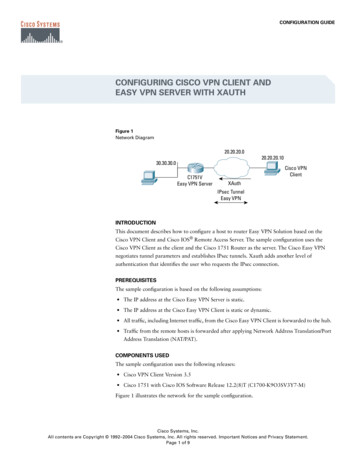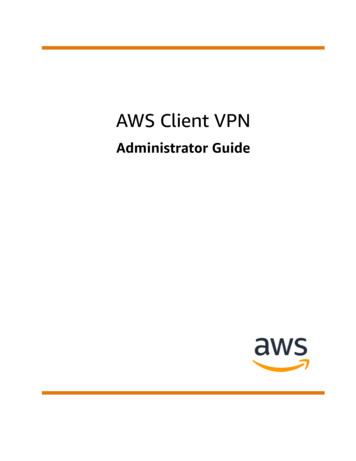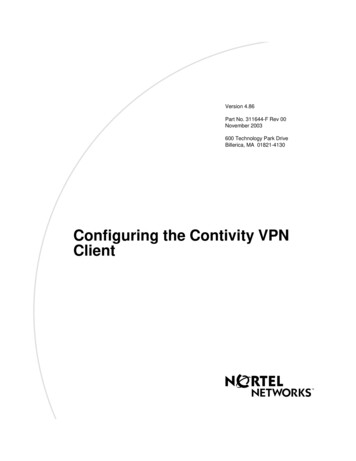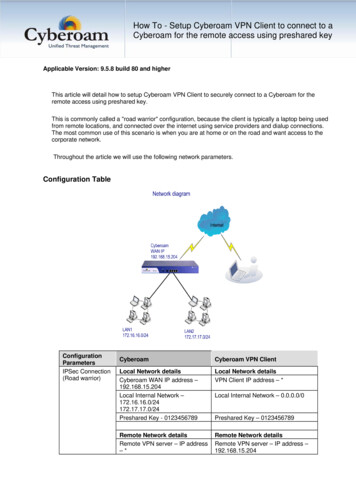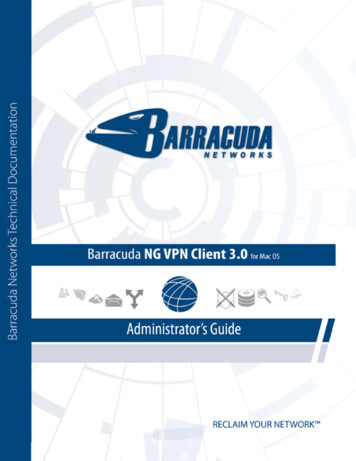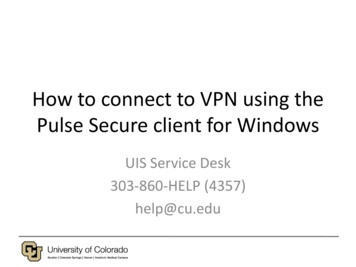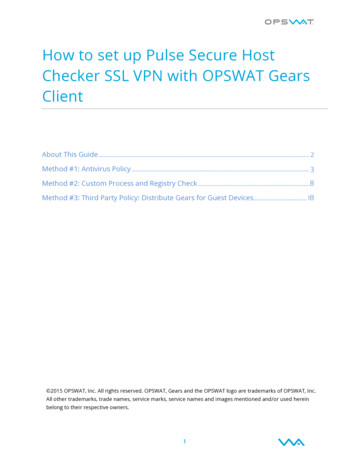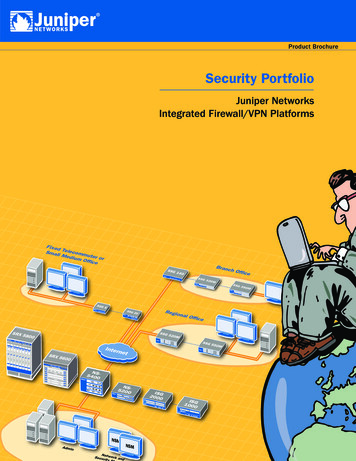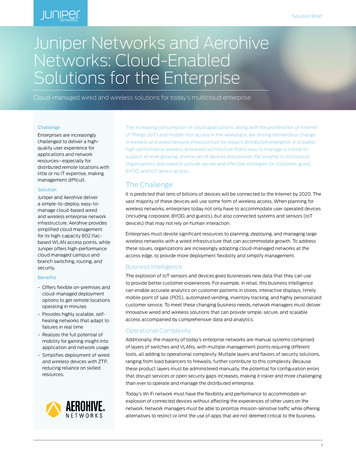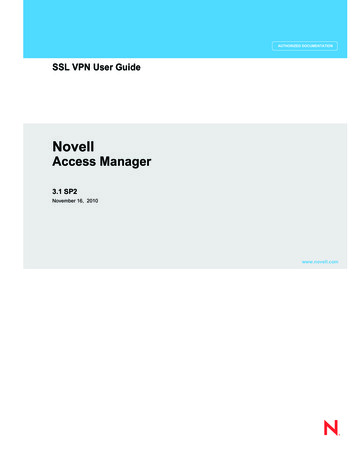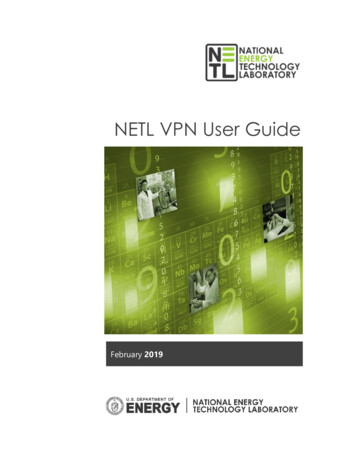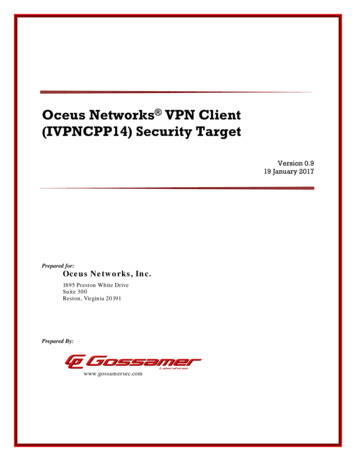
Transcription
Oceus Networks VPN Client(IVPNCPP14) Security TargetVersion 0.919 January 2017Prepared for:Oceus Networks, Inc.1895 Preston White DriveSuite 300Reston, Virginia 20191Prepared By:www.gossamersec.com
Oceus Networks VPN Client (IVPNCPP14) Security Target1.Version 0.9, 19 January 2017SECURITY TARGET INTRODUCTION .31.1SECURITY TARGET REFERENCE .31.2TOE REFERENCE .31.3TOE OVERVIEW .41.4TOE DESCRIPTION .41.4.1TOE Architecture .41.4.2TOE Documentation .62.CONFORMANCE CLAIMS .72.13.CONFORMANCE RATIONALE .7SECURITY OBJECTIVES .83.1SECURITY OBJECTIVES FOR THE OPERATIONAL ENVIRONMENT .84.EXTENDED COMPONENTS DEFINITION .95.SECURITY REQUIREMENTS . 105.1TOE SECURITY FUNCTIONAL REQUIREMENTS . 105.1.1Cryptographic support (FCS) . 115.1.2User data protection (FDP) . 135.1.3Identification and authentication (FIA) . 135.1.4Security management (FMT) . 145.1.5Protection of the TSF (FPT) . 155.1.6Trusted path/channels (FTP) . 155.2TOE SECURITY ASSURANCE REQUIREMENTS. 155.2.1Development (ADV) . 165.2.2Guidance documents (AGD) . 165.2.3Life-cycle support (ALC) . 175.2.4Tests (ATE) . 185.2.5Vulnerability assessment (AVA) . 186.TOE SUMMARY SPECIFICATION . 196.16.26.36.46.56.6CRYPTOGRAPHIC SUPPORT . 19USER DATA PROTECTION . 23IDENTIFICATION AND AUTHENTICATION . 23SECURITY MANAGEMENT . 23PROTECTION OF THE TSF . 24TRUSTED PATH/CHANNELS . 25LIST OF TABLESTable 5-1 TOE Security Functional Components . 10Table 5-2 Assurance Components . 16Table 6-1 CAVP Algorithm Certificates . 19Table 6-2 CSP Identification and Clearing . 20Table 6-3 IPsec RFCs . 21Table 6-4 Supported DH Groups . 22Page 2 of 25
Oceus Networks VPN Client (IVPNCPP14) Security TargetVersion 0.9, 19 January 20171. Security Target IntroductionThis section identifies the Security Target (ST) and Target of Evaluation (TOE) identification, ST conventions, STconformance claims, and the ST organization. The TOE is Oceus Networks VPN Client provided by OceusNetworks. The TOE is being evaluated as an IPsec VPN client.The Security Target contains the following additional sections: Conformance Claims (Section 2) Security Objectives (Section 3) Extended Components Definition (Section 4) Security Requirements (Section 5) TOE Summary Specification (Section 6)ConventionsThe following conventions have been applied in this document: Security Functional Requirements – Part 2 of the CC defines the approved set of operations that may beapplied to functional requirements: iteration, assignment, selection, and refinement.oIteration: allows a component to be used more than once with varying operations. In the ST,iteration is indicated by a parenthetical number placed at the end of the component. For exampleFDP ACC.1(1) and FDP ACC.1(2) indicate that the ST includes two iterations of theFDP ACC.1 requirement.oAssignment: allows the specification of an identified parameter. Assignments are indicated usingbold and are surrounded by brackets (e.g., [assignment]). Note that an assignment within aselection would be identified in italics and with embedded bold brackets (e.g., [[selectedassignment]]).oSelection: allows the specification of one or more elements from a list. Selections are indicatedusing bold italics and are surrounded by brackets (e.g., [selection]).oRefinement: allows the addition of details. Refinements are indicated using bold, for additions,and strike-through, for deletions (e.g., “ all objects ” or “ some big things ”).Other sections of the ST – Other sections of the ST use bolding to highlight text of special interest, such ascaptions.1.1 Security Target ReferenceST Title – Oceus Networks VPN Client (IVPNCPP14) Security TargetST Version – Version 0.9ST Date – 19 January 20171.2 TOE ReferenceTOE Identification – Oceus Networks VPN Client for Android Devices, Version 2.0.0.0.2211; and OceusNetworks VPN Client for Samsung Devices, Version 2.0.0.0.2211.TOE Developer – Oceus Networks, Inc.Page 3 of 25
Oceus Networks VPN Client (IVPNCPP14) Security TargetVersion 0.9, 19 January 2017Evaluation Sponsor – Oceus Networks, Inc.1.3 TOE OverviewThe Target of Evaluation (TOE) is Oceus Networks VPN Client.The current TOE version for Oceus Networks VPN Client (OVPN), is Version 2.0.0.0.2211.The TOE provides secure remote network connectivity for Android 6.x mobile devices by implementing an IPsecVPN using the configurations defined by profiles. The IPsec VPN capabilities are the primary function of the TOE.IPsec is used by the TOE to protect communication between itself and a VPN gateway over an unprotected network.1.4 TOE DescriptionThe TOE is the Oceus Networks VPN Client (OVPN). OVPN is built from Mocana's Device Security Framework(DSF). The OVPN employs a cryptographic code base (Mocana NanoCrypto) providing IPsec/VPN encryption.The OVPN includes version 5.5.1f of the Mocana NanoCrypto library.The OVPN runs on any Android 6.x platform. There are a number of evaluated Samsung Galaxy mobile Androiddevices using this version of Android (i.e., Galaxy S6, S6 Edge, Galaxy S7 and S7 Edge).The OVPN is interoperable with current IKEv1 and IKEv2 RFCs and can utilize X509v3 certificates forauthentication of an IPsec peer. In a basic IPsec VPN connection, all traffic from the VPN client is encrypted andsent across the VPN gateway. Profiles can be defined on or loaded into a mobile device. Named profiles define theendpoints, authentication data, and cryptographic characteristics for a VPN. Profiles define the cryptographicconfiguration of IKEv1 and IKEv2, tunnel mode, as well as a large set of additional cryptographic options.The TOE stores profiles securely within the mobile device by encrypting the profile data with a key derived from apassword using PBKDF2WithHmacSHA1 (AES 256, CBC, PKCS 5 padding).1.4.1 TOE ArchitectureThe Oceus Networks VPN Client runs on any Android 6.x platform. This includes the currently evaluated SamsungGalaxy mobile Android devices using these versions of Android (i.e., Galaxy S6, S6 Edge, Galaxy S7 and S7 Edge).The OVPN is installed on the mobile device and provides an interface to define and view profiles (a set ofconfiguration values), as well as to establish and terminate VPN connections. The OVPN relies upon its platformfor random numbers with which it seeds its own DRBG. All cryptography and the IPsec protocol stack are providedby the TOE.Data stored by the OVPN utilizes the evaluated platform's Data-at-rest protections provided by the TOE platform.However, the TOE implements its own protections for profiles which use PBKDF2WithHmacSHA1 (AES 256,CBC, PKCS 5 padding).The OVPN product is a user space application that is installed as an APK. Internally it has 'application services' thatrun in the background and within the context of Java but do not run as a 'system service.' OVPN is released in twodifferent APK (Application Packages) variations to better support Samsung KNOX and other non-KNOX Androidplatforms. The underlying VPN implementation is the same for both application packages. That is, thecryptographic libraries, VPN APIs and certificate management are the same in both application packages. Thedifference between the application packages is the APIs used to integrate with third party Mobile DeviceManagement agents. The “OVPN for Samsung Devices” supports the KNOX MDM management APIs; while thenon-KNOX “OVPN for Android” uses a proprietary SDK provided by Oceus Networks. The only difference inbehavior is the handling of certificates when the revocation status of the certificate cannot be checked. The nonKNOX “OVPN for Android” will always reject such certificates, while the “OVPN for Samsung” will prompt theuser for a decision on whether to accept the certificate.Page 4 of 25
Oceus Networks VPN Client (IVPNCPP14) Security TargetVersion 0.9, 19 January 20171.4.1.1 Physical BoundariesThe Oceus Networks VPN Client runs entirely within the context of the mobile device upon which it is installed.From a cryptographic perspective, all cryptography is performed using TOE software. The TOE relies upon theTOE platform for random numbers with which the TOE seeds its own DRBG. All subsequent need for randomvalues by TOE software obtain those values from the TOE's own DRBG. The TOE also relies upon the platform toverify the validity of TOE updates.1.4.1.2 Logical BoundariesThis section summarizes the security functions provided by Oceus VPN Client: Cryptographic support User data protection Identification and authentication Security management Protection of the TSF Trusted path/channels1.4.1.2.1 Cryptographic supportThe IPsec implementation is the primary function of the TOE. IPsec is used by the TOE to protect communicationbetween itself and a VPN Gateway over an unprotected network. The TOE also provides its cryptographic servicesto support the IPsec VPN, and self-testing functionality specified in this Security Target.1.4.1.2.2 User data protectionThe TOE ensures that residual information is protected from potential reuse in accessible objects such as networkpackets.1.4.1.2.3 Identification and authenticationThe TOE provides the ability to use, store, and protect X.509 certificates that are used for IPsec Virtual PrivateNetwork (VPN) connections.1.4.1.2.4 Security managementThe TOE provides all the interfaces necessary to manage the security functions identified throughout this SecurityTarget. This includes interfaces to the user as well as to the VPN gateway. The IPsec VPN is fully configurable bya combination of functio
The TOE is the Oceus Networks VPN Client (OVPN). OVPN is built from Mocana's Device Security Framework (DSF). The OVPN employs a cryptographic code base (Mocana NanoCrypto) providing IPsec/VPN encryption. The OVPN includes version 5.5.1f of the Mocana NanoCrypto library. The OVPN runs on any Android 6.x platform. There are a number of evaluated Samsung Galaxy mobile Android
